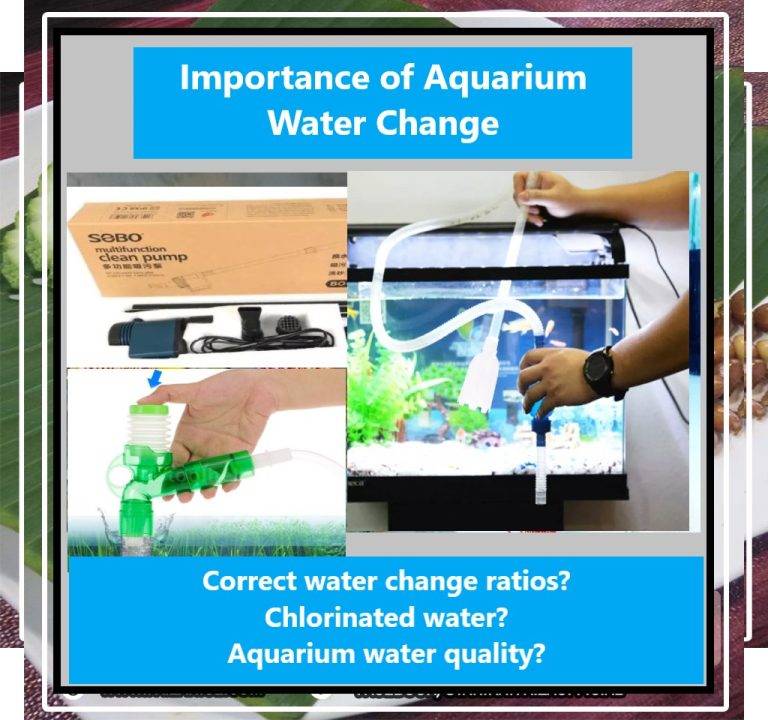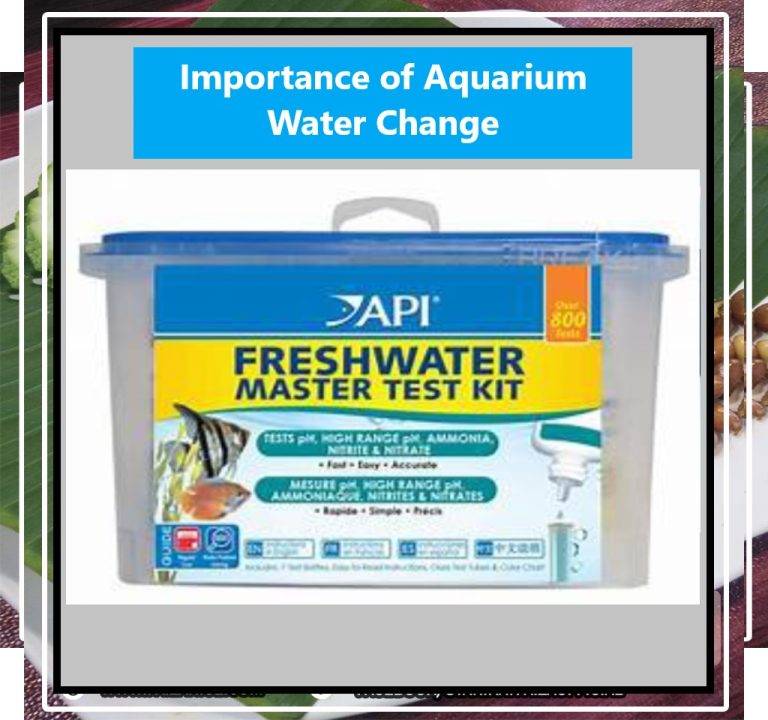Importance of Aquarium Water Change
The topic of aquarium water change is very important to ensure that fish and all aquarium life can live long. Aquarium Tips: Good aquarium water must be the same as natural occurrences such as in the Amazon River, in the ocean and others. Although in reality it is not the same, but it would be nice if we could mimic the process of the water cycle like the natural cycle of God’s creation into an aquarium!
The aquarium world is everything for ornamental fish. There is no other place for ornamental fish to go as it has limited acreage. Setup your aquarium properly so that the joy is not only on the ornamental fish, but on yourself as well!
Importance of Aquarium Water Change Summary
- Activity Name: Importance of Aquarium Water Change
- Type of Activity: Ornamental Fish
- Category: Indoor Activity
- Difficulty Level: 1 (where 1 is very less and 5 is very physical)
- Equipment Cost: $ (where $ is cheapest and $$$$$ is most expensive)
Why must you do aquarium water changes?
Aquarium water changes are necessary to maintain a healthy and balanced aquarium environment and help keep fish and other aquarium inhabitants healthy. Without regularly scheduled water changes, the nitrogen cycle can become out of balance, leading to an increase in toxic compounds such as ammonia, nitrates and phosphates. A water change helps by removing these compounds which can be harmful to fish and other aquarium inhabitants.
Additionally, regularly changing the aquarium water helps maintain optimum water parameters and prevents the build up of organic waste, helping to keep the aquarium clean and healthy. Additionally, water changes help replenish beneficial trace elements and minerals which are essential to the health of aquarium inhabitants.
Why does aquarium water need to be changed periodically?
Healthy fish need clean water to continue living in the aquarium. You need to make sure the aquarium nitrogen cycle process is not disrupted. Changing the water is one of the processes to prevent fish food waste and waste that is not trapped by the filter to be a threat and harmful to fish health. Aquarium water should be changed periodically to ensure a perfect aquarium nitrogen cycle process.
Tell us about Aquarium Water Changes
Aquarium water changes are a necessary part of keeping a healthy aquarium. Doing regular water changes removes dissolved waste from the water, replenishes trace elements, and helps maintain proper water chemistry. When performing water changes, you should use an aquarium vacuum and bucket to safely remove water from the aquarium. Fresh dechlorinated tap water should then be added back to the aquarium to replace the water that was removed.
It is important to remember to match the temperature and pH of the new water to the existing water in the aquarium. As a general rule of thumb, experts recommend 10 to 25 percent water changes on a weekly basis. This will help keep your aquarium clean and your fish healthy.
What are the tools or equipment for aquarium water changes?
The tools or equipment needed for aquarium water changes include: aquarium siphon, bucket, hose, gravel vacuum, thermometer, net, water conditioner, salt, water test kit, pH test kit, and a replacement water container.
When is the right time to do aquarium water changes?
The best time to perform an aquarium water change is when the levels of nitrate, nitrite, ammonia, and hardness become too high and are affecting the health of your aquarium. This usually occurs every two weeks.
Why does feeding fish affect aquarium water quality?
The frequency of feeding your ornamental fish has an impact on the quality of the aquarium water. Water gets dirty quickly if fed in large quantities several times a day. It is best to feed your fish 2 times a day.
Aquarium Tips: Feeding fish using cheap and substandard products has a serious impact on aquarium water quality. The water quickly turns red and smells fishy because ornamental fish food products consist of low qualities of mosquito larvae, brine shrimp and others. Give fish food that is high quality and has lots of nutrients and vitamins.
Based on our experience as an aquarist, we will change the aquarium water by 50% periodically every month or 30% periodically every 2 weeks. Use a fish waste suction device (aquarium siphon vacuum) in addition to cleaning the filter sponge. Replace with a new filter sponge if torn or worn.
What are the advantages of aquarium water changes?
The advantages to perform an aquarium water changes are:
- Improved water quality: Aquarium water changes can reduce the accumulation of nitrates and phosphates in the tank, helping to improve water clarity, reduce algae growth and eliminate any unwanted odors.
- Stress relief: Aquarium water changes can help reduce stress levels in fish due to toxins found in the water.
- Nutrient replenishment: Aquarium water changes can replenish important trace elements and minerals that are necessary for a healthy and balanced tank.
- Uninvited guests removal: Aquarium water changes can help prevent infestations of parasites and other pests from taking up residence in the tank.
- Enhanced aesthetics: Regular aquarium water changes can help maintain a clean and healthy environment for your aquatic friends, giving you beautiful and enjoyable tank to look at.
How to change aquarium water properly?
The right way to change aquarium water ensures the well -being of your ornamental fish. Here are some suggestions on how to change aquarium water properly: –
- Turn off all water filter switches first.
- Remove the dirty sponge and rinse with tap water.
- Lift the aquarium decoration and rinse with strong tap water.
- Wipe the aquarium glass with a sponge or use an aquarium algae scrapper.
- Suck out using an aquarium siphon vacuum and gravel suction tools.
- Use anti-chlorine products such as Nutrafin Aqua Plus, Seachem Prime, API Stress Coat, API Tap Water Conditioner, Tetra AquaSafe Plus which have been proven to be very effective in neutralizing chlorine and chloramine.
- Pour tap water with a slow stream of water. Aquarium Tips: Pouring tap water into the aquarium with a slow stream of water can prevent the fish from being startled and scared. This method can also reduce fish stress.
- Replace all aquarium decorations, sponges.
- Turn on all filter switches.
- Lastly, put beneficial bacterial remedies like Seachem Stability, API Stress Zyme, Big Fish Nitrifying Bacteria, PSB Bacteria and other products. Aquarium Tips: Many good bacteria (beneficial bacteria) have been removed along with the water that is sucked out. So, by adding beneficial bacterial remedy, it can have a rapid effect on the reproduction of beneficial bacteria as well as purify the aquarium water!
When you do an aquarium water change, it means you have started a more efficient Aquarium Nitrogen Cycle!
How to Change Aquarium Water according to the Right Ratio?
Everyone has their own aquarium water exchange ratio according to the situation. Changing the aquarium water consistently can refresh the fish and all the life in it and can renew the Aquarium Nitrogen Cycle. But many ask, what is the correct aquarium water exchange ratio?
Based on our experience, aquarium water change is based on the quantity of fish, the size of the tank, the frequency of feeding and the health level of your aquarium.
The health level of your aquarium can be measured in the following ways: –
- Established Aquarium: If the aquarium is already established, you do not need to change the water too often.
- Newly Aquarium: Newly ‘setup’ aquariums need to change the aquarium water more often than established aquariums.
- Hospital Tank: Aquariums for sick fish need to change the water at least once a day.
Change the water according to the quantity of ornamental fish as below: –
- The greater the quantity of ornamental fish, the more often you will need to change the water.
- There is no need to change the water frequently if few fish are kept.
Change the water according to the size of the aquarium and the fish in it as follows: –
- Change the water often if the tank size is small and the quantity of fish is large.
- Change the water often if the size of the tank is large and the quantity of fish is very lively and plentiful.
- There is no need to change the water frequently if the size of the tank is small and the quantity of fish is less plentiful.
- There is no need to change the water often if the size of the tank is large and the quantity of fish is not lively and not plentiful.
Questions about Aquarium Water Changes
Why Is Chlorinated Water Dangerous to Aquarium Life?
Generally, chlorine is used to disinfect water, as a bleaching agent and in indoor cleaning products (toilet, floor cleaning products, etc.). Low chlorine levels of 4ppm (parts per million) are safe for humans to consume. But is water chlorine safe on your ornamental fish?
The answer is of course NO. Low chlorine levels in aquarium water will make the fish stressed and restless but if high chlorine levels can be fatal.
How Do We Know the Presence of Chlorine in Water?
Apart from rust, tap water also has chlorine and can be identified by the smell that hurts, pungent and irritates your nose.
But how do we identify the presence of chlorine in aquarium water? There are several ways to measure the level of chlorine in aquarium water. We use aquarium products such as the Bettas Chlorine Tester. Bettas Chlorine Tester is formulated from Germany and is very easy to use. Bettas Chlorine Tester can give fast results in just a few seconds.
How to Use Bettas Chlorine Tester?
Very easy to use Bettas Chlorine Tester. Pour a little tap water in the lid container and add a few drops of Bettas Chlorine Tester. Notice the change in watercolor earlier. If the water tested is white (clear) means no chlorine, yellow means low chlorine and orange means high chlorine.
The results of the yellow and orange water in the previous experiment showed that fish cannot live in water that contains chlorine and causes your fish to die. That is the end of the topic of the importance of aquarium water exchange. Good aquarium water will ensure the health of ornamental fish. Don’t forget to change the aquarium water regularly! Want to know what the Aquarium Nitrogen Cycle is? Let’s get the info in the next post.

